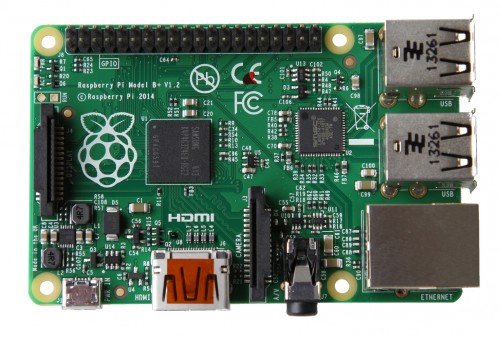 Once the Raspberry Pi Foundation set the hacker board price record two years ago with its $35 Raspberry Pi Model B, it could never go back. Whatever novelties that might appear in the next-generation Pi would have to be added without raising the price.
Once the Raspberry Pi Foundation set the hacker board price record two years ago with its $35 Raspberry Pi Model B, it could never go back. Whatever novelties that might appear in the next-generation Pi would have to be added without raising the price.
The Raspberry Pi Model B+ which launched this week for $35 at online retailers like Element 14 and R2, does a good job with this balancing act. While many Pi fans will be upset that there’s no advance from the ARM11-based Broadcom BCM2835 system-on-chip to a more robust Cortex-A processor, by sticking with the same SoC and keeping the RAM at 512MB, the Model B+ avoids controversies over software compatibility and keeps the cost within reach for students and tinkerers.
With the Model B+, the Pi may lose some of its millions of devotees to faster hacker SBCs like the Cortex-A8-based BeagleBone Black ($55), Pi-compatible, Cortex-A7-based Banana Pi ($49), or even faster, quad-core, Cortex-A9 Odroid-U3 ($59). However, the B+ adds enough connectivity to match or exceed the competition on that score.
Model B+: More USB, Greater Expansion
The major enhancement to the Model B+ is the addition of two more USB ports for a total of four. All four have improved hotplug and overcurrent behavior, according to the Pi Foundation. In other words, Pi users can avoid costly, ungainly USB hubs.
The B+ also advances from a 26-pin GPIO connector to a pin-compatible 40-pin connector, which is claimed to handle most expansion boards without modification. As a result, the Pi can support more interfaces, sensors, motor controllers and the like at the same time. Other enhancements include an improved audio circuit, as well as switched, as opposed to linear regulators, which reduces power consumption by a claimed 0.5 to 1 Watts.
Two other changes move away from legacy interfaces, as well as the original focus of providing a cheap computer for students to plug into the antiquated gear found in schools. First, the too-tight fitting SD slot has been replaced by a more modern, and easier to connect microSD slot. Also, the Composite video port has been integrated into the 3.5mm stereo out jack, and now requires an extra-cost adapter to plug in. Apparently, even in schools, HDMI is becoming standard issue.
All told, that’s not a bad mix of features, considering the $35 price. The only SBCs that can match that price run OpenWRT Linux on low-end MIPS processors, such as the new DPT Board Indiegogo project from DPTechnics.
Granted, at $35, pricing is more of a psychological barrier than a hard-nosed business issue. Whether you’re hacking together a home automation device, a robot, or a science experiment, spending an extra $20 or so for your single board computer is not a major factor. It does, however, make a difference for developers of clustering projects like lighting arrays, as well as budget-constrained organizations such as schools.
Even if it is mostly a matter of impression over ROI, psychology is as real and powerful now as it was two years ago when the Pi took the hacking world by storm. One could argue that the foundation and its manufacturing partners would have had the necessary volume to add a Cortex-A7 SoC and boost RAM to 1GB without raising the price more than $10. It’s also likely that most Pi fans would have applauded. After all, we have yet to hear about mass defections from the BeagleBone Black after the Rev C jumped in price from $45 to a current $53 — and BeagleBoard.org didn’t even upgrade the processor.
Pi is Listening to Its Users
Meanwhile, Pi owners and other would-be hackers looking for more power will have to wait for the next big thing. In the Model B+ blog announcement, the Raspberry Pi Foundation notes that this is not “Raspberry Pi 2,” but rather the final revision of the Pi. That would suggest that something like a Pi 2 could arrive by next year.
For the time being, assuming most expansion boards actually work in the new 40-pin connector, the Model B+ should fit in smoothly. The Pi Foundation can avoid fragmentation issues caused by software incompatibility while still showing it hasn’t fallen asleep at the wheel.
Despite finally posting documentation for the Broadcom SoC’s VideoCore IV GPU. the Pi Foundation still gets criticized for not being as open as many other community-based SBC projects. Yet, it ably performs one of the key tasks of a community project: listening to its users. The USB limitations were getting to be a problem, and a growing number of users who trained on the Pi have moved to other boards with more expansion pins. As for the users who dared to crave more than a decade-old processor architecture, well, two out of three ain’t bad.


